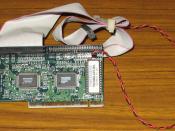RAID
In computing, a Redundant Array of Independent Disks (more commonly known as a RAIN array) is a system of using multiple hard drives is a system for sharing or replicating data among the drives
The basic idea behind RAID is to combine multiple small, inexpensive disk drives into an array to accomplish performance or redundancy goals not attainable with one large and expensive drive. The underlying concept of RAID is that data may be distributed across each drive in the array in a consistent manner. To do this, the data must first be broken into consistently sized chunks, often 32K or 64K in size, although different sizes can be used. Each chunk is then written to a hard drive in RAID according to the RAID level used. When the data is to be read, the process is reversed, giving the illusion that multiple drives are actually one large drive.
The main benefits in which RAID will provide are data protection and availability. RAID protects your data in the unlikely event of a drive failure. If a disk drive fails in a RAID system, network clients are unaware of the incident and they continue on with their work as if nothing happened. The RAID system continues to perform read/write operations and if a hot spare is available then it automatically becomes part of the array and data that was on the failed drive is automatically regenerated onto this new drive in the array. The various levels of RAID architectures as described by Charles M. Kozierok are defined below.
RAID is a method of combining several hard drives into one logical unit. It can offer fault tolerance and higher throughput levels than a single hard drive or group of independent hard drives. RAID stands for Redundant Array of Inexpensive (or sometimes...


